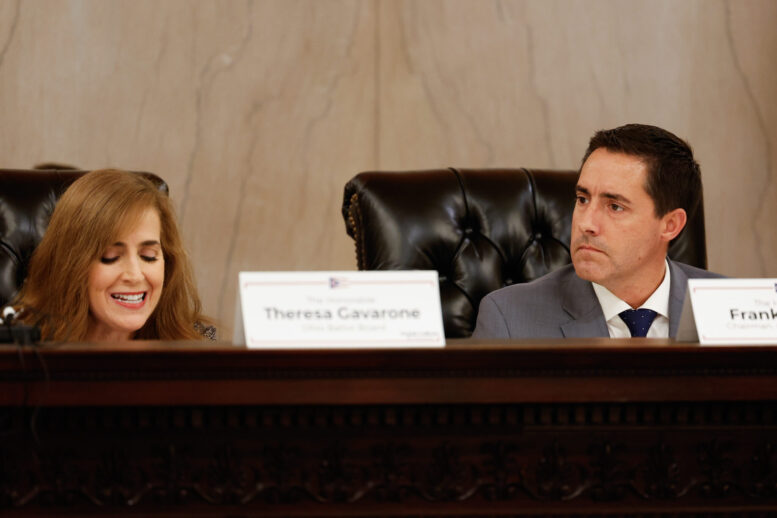BY SUSAN TEBBEN
The case against the Ohio Ballot Board’s summary of Issue 1 now includes Ohio’s House and Senate Democratic leaders, along with further arguments from the creators of the proposed constitutional amendment to reform redistricting and end gerrymandering by replacing politicians with a citizen commission.
The lawsuit accuses the board, led by Ohio Secretary of State Frank LaRose, of adopting a summary for the amendment that misleads voters into believing the amendment does the opposite of what the actual language states.
“The Amendment seeks to establish a citizen-driven redistricting process, free from domination by self-interested politicians, that operates openly and with accountability to Ohio citizens,” said attorney Don McTigue, writing on behalf of the Citizens Not Politicians coalition, creators of the proposed redistricting amendment.
McTigue said in the view of those supporting the amendment, now called Issue 1 on the November ballot, the measure would be a “vast improvement” over the current process, in which the Ohio Redistricting Commission, made up of seven elected officials decides the makeup of district maps.
Under the current process, the commission spent two years going back and forth on maps, adopting a grand total of six Statehouse district maps and two congressional district maps. Five of the six Statehouse maps were approved by the Republican majority only, and those five were all ruled unconstitutionally gerrymandered by the Ohio Supreme Court. Both congressional maps were also found to be unconstitutional.
The sixth Statehouse map was approved with a bipartisan majority (and upheld by the Ohio Supreme Court after a lawsuit), but the two Democratic members of the commission, House Minority Leader Allison Russo and Senate Minority Leader Nickie Antonio, said they voted to approve the map not because they approved of the districts, but to take the process out of the hands of the commission.
In order to allow voters to understand November’s proposed amendment — which would replace the politicians on the current redistricting commission with a 15-person citizens redistricting commission — McTigue said the summary adopted by the Ohio Ballot Board must be struck down and rewritten.
“This Court must decide whether the Ballot Board and the Secretary of State will be held accountable to their obligation to adopt ballot text that fairly and accurately represents a citizens-initiated ballot measure, or whether they have free rein to adopt language and a title that are plainly designed to persuade against the amendment,” McTigue wrote in a merit brief.
The changes made by the Ohio Ballot Board only pertain to the summary that will appear on ballots in the November election. The actual language of the amendment that will go into effect if passed remains the same as it was when Attorney General Dave Yost certified it in Nov. 2023. The summary does not change the amendment itself and does not change what the amendment would do.
The Ohio Attorney General’s Office argued to the court in its own brief that the summary language adopted by the board “accurately identifies the substance of the proposed constitutional amendment that voters will consider in the upcoming 2024 general election.”
“The ballot language does not mislead, deceive or defraud voters as to the substance of the amendment either,” claimed Julie Pfeiffer, deputy attorney general, in court documents.
Pfeiffer defended the summary language written by LaRose and his staff, saying paragraphs such as the one that states the amendment would “eliminate the longstanding ability of Ohio citizens to hold their representatives accountable for establishing fair state legislative and congressional districts” are statements that tell voters “precisely what the Amendment would do.”
“The Amendment would replace these accountable elected officials (on the Ohio Redistricting Commission) with a commission consisting entirely of appointed members,” Pfeiffer argued to the court. “And, indeed… they would not be accountable to anyone other than themselves, because they could not be removed except by the commission itself.”
Therefore, Pfeiffer wrote, the summary language is “accurate and not false or misleading.”
McTigue called arguments made by the AG’s Office “an exercise in linguistic hair-splitting” to claim the summary and amendment title adopted by the board were “technically accurate.”
“Such language and title fail constitutional muster,” McTigue wrote.
Democrats support lawsuit, pressure LaRose for answers
Members of the Ohio House and Senate Minority Caucus recently filed their support for the lawsuit, with state Rep. Beryl Brown Piccolantonio, D-Gahanna, sitting in as attorney for the caucus leaders, alongside McTigue and several members of the Elias Law Group, attorneys for Citizens Not Politicians. The caucuses filed an amicus brief, or “friend of the court” brief, which is written on behalf of those who aren’t named parties in a lawsuit, but who share a significant interest in a particular case.
“The path to arriving at this particular ballot language has been fraught with backroom meetings, political agendas and a stunning lack of transparency,” Piccolantonio wrote in the brief. “Ohioans deserve more from their elected officials.”
The minority caucuses noted their agreement with court challengers that the ballot board actions “are unlawful and represent a marked divergence from its bipartisan and ministerial role,” according to the brief.
The caucuses specifically pointed to a paragraph written by state Sen. Theresa Gavarone, R-Bowling Green, that states the proposed amendment would “establish a new taxpayer-funded commission of appointees required to gerrymander the boundaries of state legislative and congressional districts to favor either of the two largest political parties in the state of Ohio.”
That paragraph was added during the ballot board meeting in which the language was adopted by Gavarone, LaRose and fellow board member William Morgan.
Piccolantonio argued on behalf of the Democrats that the summary language twists the definition of gerrymandering, and implies the opposite of what the amendment proposes.
“The majority of the ballot board has chosen to craft a new definition of gerrymandering positing that a citizens’ redistricting commission – specifically and clearly charged with ending partisan gerrymandering and producing fair district maps that are reflective of voters’ real preferences – is the gerrymander,” Piccolantonio wrote in the caucuses brief.
The caucuses also take time in the brief to call out the secretary of state for not answering public record requests for information about “who was involved in the drafting of the language and the basis for the language.”
“These legislators did this because they had questions around how this language became so egregiously misleading and who was working with the Secretary of State to compose it,” the brief stated.
During the Aug. 16 ballot board meeting, LaRose took credit for the writing of the summary “with the help of my team and based on the input of those that are for and those who are against the issue.”
Outside of the lawsuit, one member of the minority caucus is asking further questions of LaRose related to ballot board actions on the new Issue 1.
State Rep. Bride Rose Sweeney, D-Westlake, said LaRose should be required to “publicly guarantee” materials related to Issue 1 will not include “political tampering and influence.”
Sweeney said this after the Ohio Controlling Board approved a appropriation Monday of $405,000 as requested by LaRose’s office “for the publication of a statewide ballot issue and arguments for and against the issue, as required by the Ohio Constitution,” according to the request.
Publication of statewide ballot issue materials is required for three consecutive weeks prior to the election “in at least one newspaper of general circulation in each county of the state where a newspaper is published,” the request stated, citing the state constitution.
“Before the state allocates the $405,000 in controlling board funds (LaRose has) requested, he owes it to the voters that he will publicly guarantee that as the state’s chief election officer, any materials his office sends to news outlets across Ohio detailing the arguments for and against Issue 1 are free of partisan attacks and lies,” Sweeney said in a statement.
A motion by Sweeney to defer the measure to a future meeting was voted down, and the funding request was approved 5-2.
Motion to strike
Meanwhile, a battle among the Ohio Ballot Board members may be resolved as the state’s highest court mulls over the legality of the summary language.
State Sen. Paula Hicks-Hudson and state Rep. Terrence Upchurch, stand as the two Democratic members of the ballot board, and also stand as the only two who voted against LaRose’s summary language and title when the board met in mid-August.
For that reason, the two took issue with the Ohio Attorney General’s Office speaking on their behalf when it argued against the court challenge to the language.
The Democrats took such issue with the AG’s Office move that they filed their own answer to the lawsuit without separate attorney representation. The two Democrats said in the filing that the ballot board “as a whole violated its constitutional duty.”
The AG’s office then asked the state supreme court to remove the Democrats’ separate answer to the lawsuit, arguing that allowing “the losing side” of a board vote to insert themselves in legal proceedings “would radically alter the structure and operation of Ohio’s government,” according to T. Elliot Gaiser, solicitor general for the AG.
“If non-prevailing members of boards, commissions and legislatures can litigate whenever they lose, there is no limit to the mischief this would work,” Gaiser wrote. “A single member of any multimember state board could threaten to challenge and derail any and all of that board’s decisions.”
“That way lies madness,” Gaiser continued, asking the court not only to reject the brief written by Upchurch and Hicks-Hudson, but to release a court order that would serve as a “decisive rejection of such attempts.”
Hicks-Hudson and Upchurch said in a response to the AG’s office motion that they “emphatically disagree with the reasoning” for the motion, but nevertheless asked the court to withdraw their answer on Sep. 6.
They “do not want a sideshow legal issue to distract from the real issue in this case: whether the majority of the Ballot Board adopted deceiving, misleading and fraudulent language,” according to the Sep. 6 filing.
The state supreme court had not ruled on the motion or the withdrawal as of Monday.




